To satisfy the requests received to publish the papers presented at the “Symposium Punch: Between Myth, Tradition and contemporaneity” (21, 22 and 23 November 2013, at the Theatre Institute of Barcelona, organized by the magazine Puppetring see here), and having already published the English version of Karim Dakroub the shadow theater in the Arab world (see articles here), that the presentation by Cengiz Özek, Karagöz Master and director of the International Puppet Festival of Istanbul.

People attending the Symposium Polichinela in Barcelona.
Karagöz was born in Istanbul. The art spread from Istanbul to the different parts of the Ottoman Empire across Greece, Bosnia and Romania in the Balkans and Syria, Egypt Tunisia and Algeria in the Middle East and North Africa, and also Cyprus.
Karagöz quickly became an important form of entertainment from the 17th century. The art was often experienced at festivities, circumcisions and Ramadan events and was a favourite form of entertainment at the cafes and mansions.
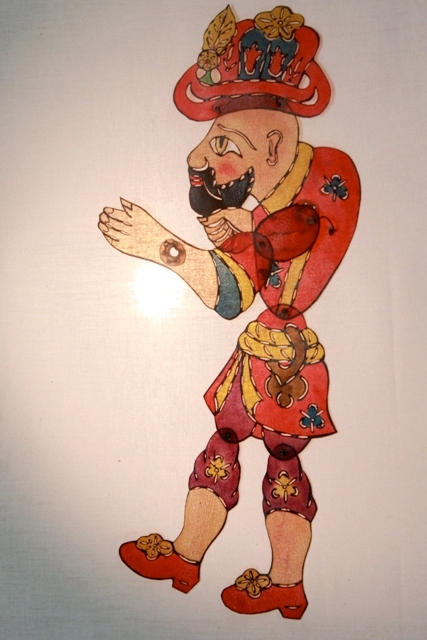
Karagöz, by Cengiz Özek.
Construction of the plays.
There are four main segments in Karagöz plays.
* Intro
* Dialogue
* Main story
* Outro

Cengiz Özek and Stefan Carelius, in the Simposium of Barcelona.
1 – Intro: Before the show starts a figure, which is unaffiliated with the show itself, is moves across the screen for a short visual shadow sequence accompanied with the sounds of a sizzling sounding mouth instrument called nareke. This is followed by one of the main characters, Hacivat, who enters the screen with songs and poems. He invites Karagöz down. Karagöz is always reluctant, but ends up coming down to fight with Hacivat. The segment ends here. All Karagöz shows start like this.
2 – Dialogue: In this part Karagöz and Hacivat have a conversation. Even if this part is written in the script, the duration varies depending on the connection with the audience and the skills of the shadow master. Karagöz makes references to political topics and tries to hold the pulse of the audience high. Hacivat ends this segment by mentioning the subject of the main story.
3 – Main Story: The Karagöz plays have a great variety.

Hacivat, by Cengoz Özek.
The themes.
a – Social situations
Example:
– Abdal Bekçi, Kanlı Nigar (The Bloody Lady) women bringing men home
– Ters Evlenme (The Reversed Wedding), alcohol problems
– Salıncak (The Swing), Yazıcı (The Clerc)

Witch.
b – Folk stories
Example:
– Ferhat and Şirin, Leyla and Mecnun, love stories

Cengiz Özek playing.
c – Surreal stories
Example:
– Kanlı Kavak, Cazular (The Witches) – Plays with connection to shamanism
In all these different kinds of performances you will find all the different people, objects and animals from Istanbul in form of Karagöz figures. Examples of architecture can also be seen. Around 400 different figures take place in the classical Karagöz repertoire. We can sort these figure in 12 different classes.

Cengiz Özek with Karagöz.
1) Main characters: Karagöz, Hacivat
2) The women
3) Characters with Istanbul dialect: Çelebi, Tiryaki, Matis
4) Anatolian characters: Laz (Black sea person), characters from Kastamonu, Kayseri, Eğinli, Harput and the Kurd
5) People from outside Anatolia: Muhacir, Arnavut (Albanian), Arap (Arab), Acem (Iranian)
6) Zımmı (Non-muslims): Rum (Ottoman Greeks), Frenk (The Frenchman), Ermeni (The Armenian), Yahudi (The Jew)
7) Mentally and/or physically handicapped persons: Kekeme (The Stutterer), Kambur (The Hunchbacked), Hımhım (A person who speaks through his nose), Kötürüm (The Crippled), Deli (The Lunatic), Esrarkeş (The Junkie), Sağır (The Deaf), Aptal or Denyo (The Idiot)

Old Karagöz coffe show.
8) Bullies and alcoholics: Efe, Zeybek, Matis, Tuzsuz, Sarhoş, Külhanbeyi
9) Entertaining characters: Köçek (Dancer Boy), Çengi (Dancer Woman), Kantocu (Woman Singer), Hokkabaz (The Juggler), Canbaz (The Acrobat), Curcunabaz (Clown), Hayalcı Çalgıcı (Musician)
10) Fantasy characters and creatures: Büyücü (The Magician), Cazülar (The Witches), Cinler (Genies and Spirits), Zebani (The Daemon)
11) Temporary side characters and children
12) Decorations and accessories: House, mansion, mountain, table, sofa, etc.
4 – Outro: The main story has ended. All the characters and decors are removed and the shadow screen is completely empty like the beginning of the show. Only Karagöz and Hacivat appear. Karagöz says he is very tired and needs to rest, and apologizes if he has expressed himself wrong or insulting. Sometimes he invites a dancer to enter the screen and end the play with entertainment.

Old player.
In the last period of the Ottoman Empire Karagöz had to share the stage with İbiş (hand puppet) and Ortaoyunu, which is a staged variant of Karagöz performed by live actors. The stories and characters have great similarities with the Karagöz plays. In the final days of the Ottoman Empire there was not as much time for amusement as before because of the foreign invasions. Also long wars such as the transition from the Ottoman Empire to the Turkish Republic resulted in a great loss of the old shadow masters. Europe had greater impact on the country after the republic was established. Turkey opened new theatre academies with European theatre workers. Stanislavski methods substituted Turkish theatre. Together with this new European fashion many writers looked down on the Karagöz art, calling it crude and irritating. Through the nationalization attempts the Karagöz art was re-named as “Traditional Turkish Shadow Theatre”, thus making it an art of the whole country. However, Turkey couldn’t find its place in this multi-cultural art. The remaining Karagöz masters attempted to make new approaches to the art, but they faced difficulties on adapting these stories to the shadow screen, maybe they were not able to. In 1973 Karagöz faced great agony. The Ministry of Culture and Tourism tried to breed new Karagöz artists by opening courses with the few remaining masters. The results were Tacettin Diker, Metin Özlen and Orhan Kurt who are now recognized as living UNESCO heritages a few years ago, and a few more masters. With the students brought up by the masters who participated these courses the Karagöz art seems to be in safe hands in Turkey today.
I believe that Karagöz should be based on universal themes… and this is what I am trying with my work
Cengiz Özek



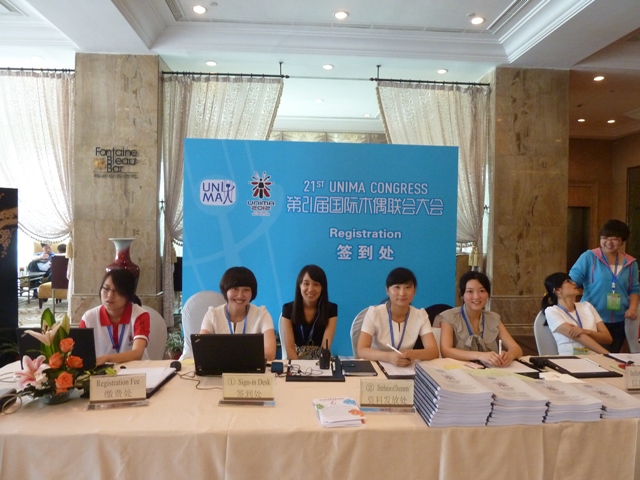


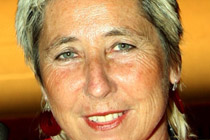




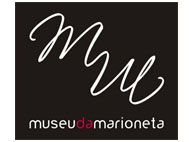


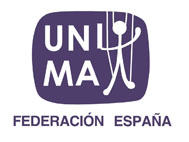








Dear Sir or Madam,
Can you help me to find a performance of Karagöz and Hacivat in Istanbul between Sept. 19, 20 and 21? I will be there for a few days and would love to see one performance if possible. I don’t speak much Turkish but it doesn’t matter, I am sure I will enjoy.
Best wishes,
Iliona Khalili